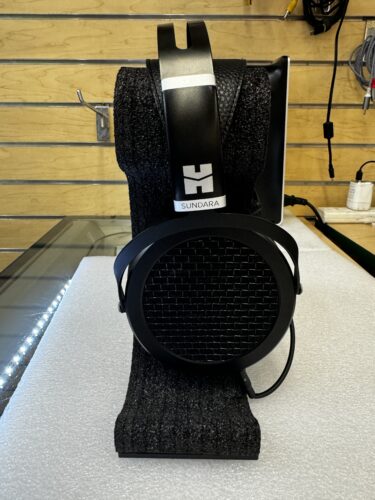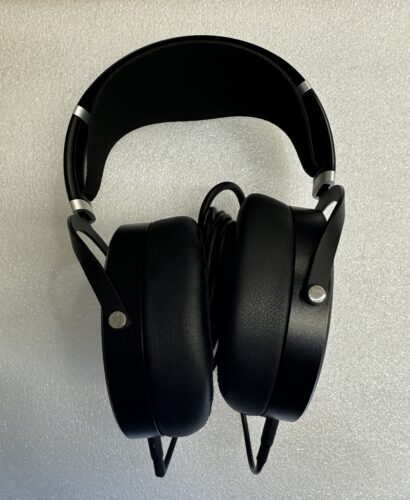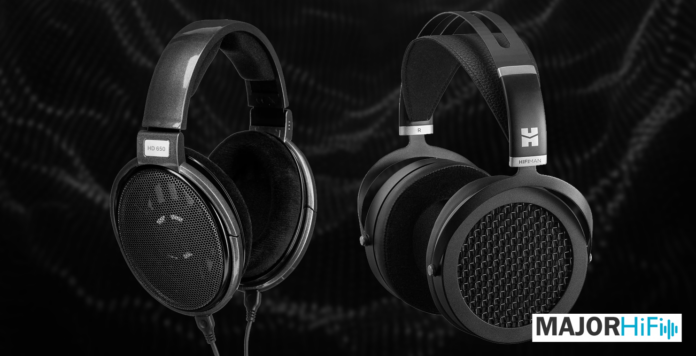For the last few years, Sennheiser and Hifiman have rivaled each other in terms of offerings at the entry-level price range. Under $500, two of the most popular headphones are the HD650 and the Sundara. But while the two have a reference sound in mind, they’re actually quite different. In 2024, both the Sundara and HD650 are still relevant, and are at the top of my list of recommendations for listeners who want to take a step up into the audiophile world. But which is the headphone for you? Sennheiser’s classic headphone that’s been lapping competition for years? Or Hifiman’s entry level cans? Find out in this comparison review.
What’s in the Box:
| Hifiman Sundara | Sennheiser HD650 |
|
|

Build:
The Sundara takes notes from higher end Hifiman models, but pares things down to meet its price point. Those familiar with the brand will recognize a mix of the old and new from the audiophile brand, with a suspension headband with streamlined yokes and circular ear pads. They’re quite light at 372 grams, which is pretty impressive for a planar headphone. And what’s really nice about these is the use of metal parts throughout the build, making them feel a bit higher quality than some of the more plasticky headphones on the market. That said, they are not the most robust feeling headphones. I’ve never personally run into any problems with them, but there is a certain steadiness that comes from higher end models that the Sundara lacks.
Meanwhile the HD650 has a bit of a leaner build. Unlike the Sundara, they do use quite a bit of plastic in the build, from the headband, to the earcups. The HD650 and HD600 are partially known for their velour ear pads as they’ve become mainstays on the headphones. Now, when I said the Sundara is light for a planar magnetic headphone, the HD650 shows how much lighter a dynamic headphone can be, clocking in at just 260 grams.
In my comparisons, I found there to be no clear winner here. Though it’s somewhat heavier, I do find the Sundara to be a bit more comfortable due to its less aggressive clamping force. But on the flip side, despite the plastic aesthetic, I find the build of the HD650 to feel a bit more reliable. And given their track record over the years, I wouldn’t hesitate to put my trust in Sennheiser’s offering.

Design:
You might have noticed by now that the Sundara and HD650 differ in one key way. The Sundara is a planar magnetic headphone while the HD650 uses dynamic drivers. The Sundara has an impedance of 37 ohms, but an SPL of 94 dB/mW. It’s not an especially hard to drive headphone, but you’ll still want to use an amplifier with them. The HD650, on the other hand, has an impedance of 300 ohms. And while they do have an SPL of 103 dB/mW, their impedance makes them harder to drive as well.
Though their numbers seem a bit different, both headphones will benefit from a DAC/Amp to give them sufficient power. Both have great total harmonic distortion numbers and have far ranging frequency ranges. So overall, I would say the choice here comes down to the type of driver you want. Currently at $279, the Sundara is an incredible deal for an entry level set of planar magnetic headphones, which, not to spoil anything, brings about its own set of sonic benefits. These include fast bass response and pristine treble. But the HD650 offers a high quality dynamic driver that competes with some headphones tiers above them. So all told, it really comes down to your sound preferences.

Sound Impressions:
As an overview, the Sundara and HD650 have different but complementary sound profiles. The Sundara is neutral-cool while the HD650 is neutral-warm. But they don’t perform on a binary scale. They each have pros and cons across the frequency range. Let’s get into some of the key differences now.
Bass:
While the HD650 is a bit warmer in timbre, its bass response is quite linear. It doesn’t have the deepest sub bass response but makes up for it with its nice midbass bump. This warms things up without bloating the sound, keeping things neutral but enjoyable. However, I do find them to be lacking in the punchiness category. Bass impact can feel lean with more emphasis on decay than attack.
The Sundara, however, takes an opposite approach. I found the Hifiman entrant to have a stronger sub bass impact while toning down midbass to make for a fast but unobtrusive bass performance. There’s more emphasis on punchiness than on the Sennheiser, but less warmth in the midbass. This allows for a dynamic bass response but also means you’ll get a brighter sounding lower midrange.
Mids:
The HD650 is famous for its warm and rich midrange. Carrying things on from the midbass bloom, the HD650 puts out a forward vocal presentation that is rivaled by very few headphones regardless of price. But just because vocals are well pronounced doesn’t mean instruments become swampy. Separation is still quite good. That said, dynamics, once again, feel a bit softer in the midrange due to its darker presentation.
The Sundara is more neutral in its midrange. Vocals are present but not quite as engaging as the HD650. However separation and dynamics are better as it feels like there’s a bit more room due to the leaner midbass/lower mids. Overall, it’s a more spacious and detailed sound. But at the same time, it doesn’t sound as musical and relaxing as the HD650.
Treble:
The treble response is where these headphones differ the most. If you’ve been doing research on Sennheiser’s HD600 line, you might have heard something about the “Sennheiser Veil.” Now, personally, I don’t think it’s so much of a veil but rather a softer presentation of treble. That said, it’s still detailed and highly resolving. It just opts for a more laid back and, again, a more enjoyable and musical sound.
The Sundara is the opposite. It’s quite a bit brighter with more attack and sparkle. Hifiman’s headphone has a great ability to present top end detail, and is fairly resolving for the price. And like the midrange, it feels like there’s more space on the Sundara for this detail to live. However, it’s not nearly as relaxing as the HD650.
Soundstage:
The HD650 is an intimate headphone, no questions about it. It relies on a strong center image to create an engaging and immediate sound. Imaging is quite good, though, with accurate placement of sounds and an ability to retrieve some widespread detail when called for. The Sundara is a bit wider and also has great imaging, though it loses some of that impact that comes from a tighter and more engaging center image.

Final Thoughts:
The Hifiman Sundara and Sennheiser HD650 are two classic headphones that fall below $500. But they are quite different from each other. For a warmer and more intimate presentation, the HD650 is a great bet. And for a brighter and more expansive headphone, the Sundara is a great entry point for audiophiles. All told, it may also just come down to price. The pricing on these models fluctuate often, but currently the Sundara can be had for as low as $279 while the MSRP on the HD650 is a bit higher at $499, though it can be quite a bit lower when on sale. At the end of the day, both headphones are great options and present great value at their respective prices.
The Hifiman Sundara and Sennheiser HD650 are available at Audio46.
MAJORHIFI may receive commissions from retail offers.








